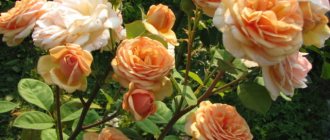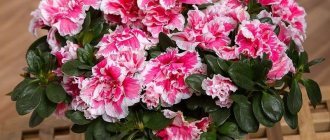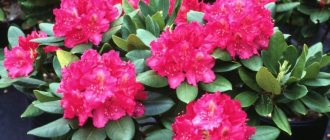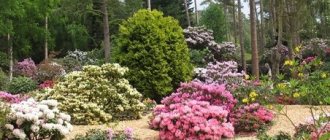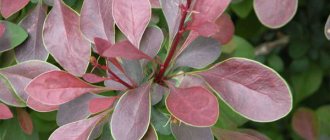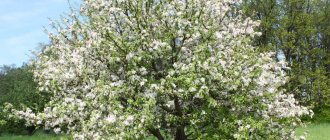Detailed description
- The ornamental bush grows up to 1.5 - 2 m. It blooms from mid-May and is an early variety.
- The bush is compact, the shape is straight and loose, with age the bush thickens and grows in a hemisphere.
- The crown is wide, reaching up to 1–1.5 m in diameter.
- The leaves are oblong, wide, up to 6 cm, pointed at the ends, 10 cm long. The leaves are wedge-shaped at the base. The color of the leaves is olive green; in autumn the leaves change color and become a rich, bright burgundy shade. The leaves fall off in winter.
- Stems - shoots branch well.
- Salmon flowers are orange, funnel-shaped, medium in size, up to 5 cm in diameter. The throat of the flower itself is lighter than the edges of the petals, they have a pink tint.
- The inflorescences are large bouquets, each inflorescence contains up to 8 - 10 flowers.
The reader may be interested in articles about other varieties of Lights azaleas:
- Mandarin Lights;
- White Lights;
- Rosie Lights.
Appearance
Representatives of the exotic azaleas of the lights series are deciduous shrubs.
Mature bushes reach an average of 1.5 - 2 m in height. The width of the bush extends to 1.3 - 1.5 m. The crown is dense, in most cases spreading. The branches are erect. The leaves are wide, up to 5 - 6 cm, grow up to 7 - 10 cm, oblong, sometimes ovate or vice versa - convex, pointed at the ends, wedge-shaped at the base. The structure of the leaves is glossy, leathery or slightly pubescent, depending on the variety. In summer, the foliage is olive green; autumn color has rich shades of burgundy and crimson. The flowers are large, bell-shaped, and have a distinct aroma. The stamens are curved and figured. The color range of rhododendron flowering is varied. There are expressive orange colors, soft yellow and golden colors, in some species the flowers become white and soft pink when blooming.
The structure of the flowers is semi-double, mother-of-pearl, shiny, carmine. The flowers are medium-sized, up to 5–6 cm in diameter. The buds ripen in late May - early June. The inflorescences are large, spherical, connecting 10 - 15 flowers.
The root is flat, consists of thin fibrous roots, tightly intertwined. It is located close to the surface, so the root system is sensitive to drying out and excessive watering.
Photo
Below you can see a photo of the Golden Lights:
House azalea, rhododendron - care, flowering, reproduction
House azalea, rhododendron - care, flowering, reproduction
What does it look like
. Azalea is a deciduous or evergreen perennial shrub, very popular all over the world, in nature with a height of 1 to 2 m, depending on the species. A huge number of varieties have been developed, differing in the shape and color of flowers. House azalea is a close relative of the rhododendron, a delicate and compact plant. Azalea leaves are dark green, oval, abundantly covering this small shrub. Its woody stems bear terminal inflorescences with an abundance of red, pink, white or purple flowers, and there are bicolor species. Azalea flowers are 2.5–5 cm in diameter, sometimes double or semi-double.
Japanese azalea – Azalea japonica
One of the evergreen subspecies of the plant, the shrubs reach a height of 2 m and bloom in spring. The leaves are oblong-oval, light green, slightly bent along the central vein, the leaf blades are glossy. The flowers are funnel-shaped, with slightly ruffled petals in all shades of pink, lilac, salmon, white or red.
Sub-varieties
Golden Eagle
On a note. The bush is deciduous, grows vertically, grows up to 170 – 180 cm in height, the diameter of the funnel-shaped crown is 1 m. It grows slowly, the bush is dense.
The leaves are oblong - long, up to 10 cm. Wide - 5 cm, bright, rich green. Shiny, tight. In autumn they change color to orange or red. The inflorescences consist of 7–9 flowers, which bloom simultaneously with the leaves. The flowers are fragrant, reddish-orange, funnel-shaped, 50-60 mm in diameter. They bloom in May. The variety has average winter hardiness.
Spix orange
Fast-growing and frost-resistant variety. The leaves are oblong, rich green. In autumn they turn orange-yellow. The bush is dense, spreading, grows up to 1.5 m in height. The flowers are soft orange, double, large flowers are cup-shaped. The flowers are collected in inflorescences of 10 flowers each. The diameter of the flower is average, up to 7 – 8 cm. It blooms in mid-May, blooms for 3 weeks.
Glowing embers
Reference. A distinctive feature is that it grows vertically, the average height reaches 1.5 - 1.8 m. The diameter of the funnel-shaped crown of an adult flower usually reaches 1 m.
The bush is dense and grows slowly. The leaves are large, up to 10 cm long and 4 – 5 cm wide. The leaves are dense, glossy, bright green. In autumn they change color to orange-red. The flowers are collected in inflorescences of 6–10 flowers each. Blooms in early June, the flowers are fragrant.
Description
The perennial shrub belongs to the Heather family, the genus Rhododendron. Natural habitat is China, Japan, North America.
Blooms 4 years after planting. It reaches a height of 0.4 to 3 m. Azalea can be evergreen or deciduous. Evergreen shrubs retain their foliage throughout the year. It is rather inconspicuous, the leaves are small with pubescence, and have the shape of an ellipse.
Flowering occurs differently depending on the variety chosen, with many species blooming in winter or even twice a year. The flowers are lush and large. The colors of the inflorescences are white, red and pink.
Azalea
In addition to being renowned for its beauty, the azalea is also highly toxic as it contains andromedotoxin in both its leaves and its nectar, including the honey from the nectar. Bees are deliberately fed azalea/rhododendron nectar in parts of Turkey, producing a mind-altering, potentially medicinal and sometimes deadly honey known as “crazy honey.” According to the ancient Roman historian Pliny the Elder in his Natural History, the army that invaded Pontus in Turkey was poisoned with such honey, which led to their defeat.
Bloom
When and how does this happen?
Rhododendron golden lights blooms from mid-May and blooms until early June. Flowering is abundant and begins simultaneously with the unfolding of leaves. It is considered a large-flowered variety.
How to care?
- During flowering, good lighting and abundant watering are necessary.
- During the formation of buds, the temperature should be reduced to 10 – 12 °C.
- After flowering, young shoots are pruned for further cuttings. It is recommended to cut off old inflorescences.
What to do if there are no buds?
- It is important to use superphosphate fertilizers to prolong flowering and the formation of new inflorescences.
- Perhaps the substrate lacks minerals; you can feed it with special fertilizers.
- It is necessary to check the bush for the presence of parasites - they interfere with the growth and flowering of rhododendron golden lights.
Planting and care
- Choosing a landing site - choose the right place without rushing. Since Rhododendron Roseum Elegans is a fairly tall shrub and loves partial shade, it is advisable to place it on the north side of the site. You can plant it next to the house or along the fence; a hedge or alley will look very chic. And the most ideal place for it would be the shore of any body of water (pond or stream).
- What should the soil be like - like any Rhododendron, of course, it needs slightly acidic soil. Coniferous litter has a good effect on the root system (and ultimately on the entire plant).
- Planting is best done in May (or late April). If you want to plant several plants at once, you need to maintain a distance between them of about 2 meters. It is better to prepare the holes all at once so that the planting line is clearly visible. A very important nuance is to provide drainage and mulch layers.
- Temperature – the minimum temperature for Rhododendron Roseum Elegance is minus 32 degrees, and the maximum is plus 30 degrees. And it will grow well and calmly within temperatures from minus 15 to plus 20 degrees.
- Watering - since the shrub grows tall, it needs a lot of water; for an adult specimen, three to five buckets of water at a time will be the norm. Periodically watering should be done with acidified water; for these purposes, use citric acid or lemon juice. The sprinkling procedure will be very useful.
- Fertilizing – both organic and mineral fertilizers are suitable, you can apply them one at a time.
- Pruning - since this species is very spreading, of course, I would like to shape it a little more compactly. It is better to start pruning after flowering has ended.
- Transplantation - of course, replanting is sometimes necessary, spring and summer are just right for this. You should not be afraid of replanting, because their root system is superficial and if the plant is pulled out with a clod of earth, the roots will not be damaged at all.
- How to prepare for winter - Rhododendron Roseum Elegans is characterized by winter hardiness, but it is better for it to winter under cover. It can be lutrasil (or spunbond), it will perfectly protect the tips of the branches from unnecessary frost and from the bright early spring sun.
Care
Selecting a location
For planting rhododendron golden lights, it is better to choose places protected from draft winds. This variety prefers light partial shade - it is afraid of direct sunlight.
What should the soil be like?
Rhododendron golden lights are planted in acidic, fertilized, loose soils. Composition of the substrate for rhododendron golden lights:
- Garden soil – 1 hour.
- Sour riding moss – sphagnum – 2 tsp.
- Drainage base.
Important! When caring, you should remember that the substrate should not dry out, but you should not allow water to stagnate - the roots begin to rot.
Landing
The procedure for planting rhododendron golden lights is performed sequentially:
Dig a deep hole, 40–50 cm deep, with a diameter of 60–70 cm.
- Drainage is placed at the bottom in a layer of 10–15 cm.
- Half the hole is filled with moss - sphagnum.
- Then they are filled with a mixture of loose soil and leaf humus.
- The planting bush is placed vertically.
- Fill with soil mixture up to the root collar.
- Mulch the soil around the bush.
It is imperative to form a drain for accumulated water.
Temperature
Frost-resistant variety, even in harsh winters it can withstand temperatures down to – 40°C. Usually this variety is not covered, but if the winter has little snow, then covering with coniferous spruce branches or burlap is recommended. Rhododendron golden lights prefers a humid, cool climate, the optimal temperature is 10 – 15°C. In summer, with additional spraying it can tolerate up to 30°C.
Watering
Rhododendron Golden Lights is very moisture-loving and requires abundant watering during growth and flowering. In late autumn and winter, watering can only be done in dry weather; watering is reduced by half.
Note! Watering should be done over the entire surface of the soil so that the surface structure of the roots is not washed away.
Top dressing
Fertilizers for rhododendron golden lights should be special, intended only for acidic soils. It is advisable to fertilize the substrate 1.5 - 2 months before the onset of frost with potassium and phosphorus fertilizers in a ratio of 1:2. In early spring, mineral fertilizers are required: 40 g per 1 sq.m.
It is not recommended to feed and replant while flower buds are forming; they may fall off.
Trimming
Golden light rhododendrons require regular pruning in the first 3 to 4 years after planting to improve branching and form a beautiful bush. You should also cut out last year's shoots that are too long - they are shortened by half.
Remove faded inflorescences in a timely manner. This cleansing promotes full bud formation.
Transfer
Transplantation is carried out in early spring, and can be replanted after flowering. Golden light rhododendrons take root well. When transplanting, the seedling is surrounded by a border of pine needles and sphagnum moss, 6–7 cm thick. This layer traps snow, which protects the roots from freezing.
Rhododendron deciduous Golden Lights (Azalea)
Azalea deciduous Golden Lights
Deciduous rhododendron from the Lights series. The bush is quite compact, round in shape, 120-170 cm high and with a crown diameter of about 150 cm. The flowers are funnel-shaped, up to 5 cm in diameter, fragrant, light yellow-orange with a lighter throat and pinkish edges of the petals, in inflorescences up to 10 pieces. Flowering from mid-May. Very resistant to fungal diseases. Winter-hardy down to -30°.
Deciduous azaleas, also known as rhododendrons, grow and bloom well in the garden with proper planting and careful care. Including in the middle zone and more northern regions, for example, in the Leningrad region and Karelia. Although many gardeners still hesitate to grow these beautiful plants, considering them capricious, slow-growing and not frost-resistant enough. And in vain. After all, the first hybrids of deciduous azalea were bred in Russia by E.L. Regel before 1917 by crossing wild Japanese azaleas and Dutch garden varieties. And today there are many more modern varieties of winter-hardy deciduous rhododendrons. Such rhododendrons feel great in gardens in the Moscow region without shelter for the winter. The pink, orange, red and yellow balls of rhododendron flowers appear in the spring when the buds on the trees begin to bloom. From one flower bud 4-6 funnel-shaped flowers are formed. Each flower is 6-8 cm in diameter. Flowering lasts about 3 weeks, but throughout the summer rhododendrons are very decorative, thanks to their beautiful greenery. And in autumn the leaves acquire red tones, becoming a special decoration of the garden.
Location of the rhododendron: when choosing a location, you need to keep in mind that it should be protected from prevailing winds and direct sunlight. Most wild rhododendrons in nature hide under the canopy of trees, and if they find themselves in the open, then on slopes where the sun penetrates only part of the day. Such “problem” places in our gardens, such as areas directly adjacent to the northern walls of the house and other buildings, are excellent for rhododendrons. They also do well in wooded areas, especially under pine trees and not very dense spruce trees.
Soil for rhododendron: heavy clay soils, soils with a dense lower horizon, where stagnation of rain and melt water is possible, are unsuitable for growing rhododendrons. Optimal soil mixture: leaf soil, peat and coniferous litter (3:2:1) with the addition of complete mineral fertilizer: 70 g per hole. Optimal soil acidity is 4.5 - 5.0.
Planting Rhododendron: The best time to plant rhododendrons is spring. At the site of future plantings, holes about 50 cm deep and at least 70 cm wide are dug in advance. Drainage is required, a layer of broken brick and sand is 15-20 cm, if the planting hole is deep, then the drainage layer increases to 30 - 40 cm and includes fine gravel or crushed stone (but not limestone). The distance between plants depends on the height and diameter of the crown of the bush and averages from 0.7 to 2 m. When planting plants, you need to ensure that their root system is not buried, but is located 2-4 cm above the soil level, taking into account its precipitation. Make a hole around the bush with raised edges and water it abundantly. Rhododendrons have a shallow root system (30-40 cm), which develops mainly in the litter and humus horizon. Therefore, mulching material is poured around the planted bushes - peat, pine needles in a layer of 4-8 cm, which retains moisture, prevents the growth of weeds, protects the roots from mechanical damage, and reduces the depth of soil freezing.
Caring for rhododendrons: involves weeding the tree trunks, watering and fertilizing. For normal growth and development of plants, the soil should be fertilized once every 2-3 years. In the spring, one bucket of nutrient mixture (rotted cow manure, decomposed compost) is added to the tree trunk circle at a shallow depth. In early spring, rhododendrons are fed with mineral fertilizers containing NPK in a ratio of 2:1:1.5 (ammonium sulfate, superphosphate, potassium sulfate) at the rate of 30-40 g per sq.m. The plants are fed a second time after flowering with a mixture of 2 parts phosphorus and 1 part potassium fertilizer, which promotes the formation of flower buds for the next year. If necessary, you can feed them in the summer. But not at the end of it, otherwise this may cause untimely growth of shoots and their freezing in winter. Large doses of superphosphate are dangerous - they create iron deficiency. Fertilizers containing lime and chlorine should be avoided. It is better to feed young plants with low concentrations of mineral fertilizers in liquid form.
Regular watering, abundant in the dry and hot season, 10 - 12 liters per plant 2-3 times a week. Spray the plants whenever possible, especially during the period of active growth and water if there is even the slightest suspicion that they are deficient water. The surest sign of this is that the leaves become dull and droop, and brown spots appear along their edges, similar to fungal diseases. Ideally, water for watering rhododendrons should be soft (rain or snow) and acidic, and should not contain a lot of salts. Shallow loosening, after watering. Frequently loosening is not recommended, since the roots are located on the surface. It must be borne in mind that when weeding, you should not loosen the soil in the immediate vicinity of the bushes, as there is a risk of damaging their roots. It is better to leave pulled out weeds right under the bush, thereby providing an additional layer of mulch. In the first year after planting, it is better to break off all the buds so as not to weaken the fragile plant (leave a couple if you are eager to make sure that you have chosen exactly the variety you wanted). In adult plants, after flowering, only a part of the well-developed fruits is left for collecting seeds; excess fruits are removed, which contributes to better flowering of the plants next year. For successful overwintering, you need to water the bushes abundantly before the start of winter, before the soil freezes. In the first 2-3 years after planting, it is recommended to cover evergreen rhododendrons with spruce branches, low-growing rhododendrons with a completely dry oak leaf, more heat-loving varieties can be covered with craft paper or roofing felt, which is stretched over the frame. For deciduous rhododendrons, bending branches to the ground is used so that they are covered with snow in winter. At the end of March - beginning of April, the cover is removed, sometimes leaving part of the spruce branches on evergreens for a short time to avoid spring sunburn.
Reproduction of rhododendrons: by seeds and vegetatively (layering, cuttings). Wild species are usually propagated by seeds, and varieties are most often propagated by layering and cuttings. Sowing of seeds is carried out in spring in bowls or boxes, if there are a lot of seeds; small seeds are sown on the surface of the substrate or lightly sprinkled with clean, washed sand, watered generously with water, preferably soft (rain or melted snow). Tap water is acidified by adding 3 - 4 g of oxalic acid per 10 liters of water. The boxes are covered with glass or film to maintain high humidity. A mixture of peat and sand, taken in equal quantities, is suitable as a substrate. Before filling into boxes, the soil mixture is etched with a strong solution of potassium permanganate. At room temperature, seedlings appear after 3-4 weeks, in some species - after 18 days. When the first leaves appear on the seedlings, they should be moved to a room with a lower temperature, about 8 - 12°C. Then the seedlings are less damaged by diseases. In summer, boxes with seedlings can be taken out into the garden and placed in a protected place, sufficiently lit, but not exposed to direct sunlight. Rhododendrons grown from seeds bloom in the fifth to tenth year. Plants obtained from rooted cuttings may bloom the following year. Rooting substrate: peat and sand (1:1), or sawdust and sand (3:1), or a mixture of peat, perlite, sand (2:2:1). For cuttings, semi-lignified cuttings of rhododendrons are used. They are cut in the second half of June, the length of the cutting is 5-8 cm, an oblique cut is made at the bottom. The lower leaves on the cutting are removed, and the upper 2-3 are left completely. The cuttings are treated with growth stimulants: indolylbutyric, indolylacetic, succinic acid in a concentration of 0.02% and kept in them for 12-16 hours; for difficult-to-root varieties, the concentration is 2 - 4%. Then the cuttings are immersed in the substrate at an angle of 30°, pressed, watered and the box is covered with glass or film. Cuttings root better at a substrate temperature of 24 - 26 ° C, and the air temperature is 2 degrees lower. A prerequisite is high soil moisture and air surrounding the cuttings. Illumination of cuttings (60 W for 4-5 hours a day) speeds up the rooting process. Deciduous rhododendrons take root after 1.5 months, evergreen ones - after 3-4.5 months. Rooting results depend on the species and variety. The easiest way to propagate deciduous azaleas is by layering. This process is carried out in early spring. Last year's shoots are used. They are tied with copper wire and dug in, secured in the ground using special hooks or improvised materials: slingshots or crossed sticks. You must remember to moisten the surrounding soil regularly throughout the summer. For better rooting, once every 20-30 days you can water the layering with a solution of heteroauxin. Separation from the parent plant is carried out only the following year in the fall. But a new azalea will bloom in the spring of next year.
Uses of rhododendrons: Rhododendrons look most impressive in loosely arranged groups. It is advisable to place plantings along the edges of lawns, near paths and paths. Since rhododendrons are moisture-loving plants, they are best planted near bodies of water: ponds, swimming pools, fountains, where in the summer, due to the high humidity and moderate temperature, the conditions are most favorable. There should be at least 3 plants, and at least 1 sq.m should be allocated for each. In the absence of adult specimens, dense plantings of young ones can be used with the expectation that as they grow they will become sparse. When creating groups, it is not recommended to mix deciduous and evergreen rhododendrons. If different species are planted nearby, then they must be selected according to height: in the center - the highest, at the edges - the lowest. Rhododendrons are very decorative next to coniferous plants: spruce, pine, thuja, yew. Plants with bright colors are especially impressive against a monochromatic dark background. Evergreen trees and shrubs planted from the south, east or west protect rhododendrons from cold winds, winter drying out and spring sunburn. Since light partial shade is preferred for the normal growth and development of rhododendrons, they can be successfully planted between large, old trees or on the north side of buildings. The area on the south side is not recommended for planting, especially for evergreen species. In this case, the plants are more susceptible to diseases, their leaves turn yellow, growth and flowering weaken. When placing rhododendrons in groups, you should strictly ensure that they are composed of varieties and species that are harmonious in flower color. The most decorative is the proximity of plants with purple, pink and white colors or with various contrasting shades. Rhododendrons with yellow and orange flowers look amazingly good in plantings. Soft yellow tones effectively set off brighter ones. Rhododendrons are beautiful not only in groups, but also in solitary plantings. They are especially good on parterre lawns, but it should be taken into account that the decorative effect is maximum when using an adult (at least 10 years old), preferably tall (1.5-2.0 m) plant, otherwise it will be “lost” on the lawn. Rhododendrons are also used to create hedges and rocky hills. For rock gardens, the most suitable are small-flowered, low-growing varieties in combination with alpine species of herbaceous plants. In such plantings, rhododendrons should be planted only in groups, which gives a greater effect during flowering.
Reproduction
Rhododendron golden lights are propagated at home by cuttings:
In the spring, when buds are planted, cuttings 6–8 cm long are cut.
- The cut should be oblique; the edges at the base of the cutting should be carefully cleared of bark.
- The cuttings are dipped in a solution with a root growth stimulator for a day.
- For rooting, they are planted in a prepared special substrate to a depth of 2 cm at an angle of 30°.
- Water well and cover with glass or film.
- Soil temperature – 24 – 26°C, air temperature should be 2 – 5 degrees lower.
- Seedlings take root very slowly, up to 1.5 months.
Important! Composition of the rooting substrate: sawdust – 3 parts, sand – 1 part.
Step-by-step instructions for growing
Selecting a location
Planting sites for White Lights rhododendron should be quiet, protected from strong winds and drafts. The variety loves light, but the bright sun can leave burns on the leaves; it is recommended to plant the bushes in semi-shaded places, near ponds, pine trees, and juniper bushes.
What should the soil be like?
Rhododendron White Lights grows well only in acidic, loose, humus-rich soils. A drainage layer during planting is required for breathability.
Soil composition:
- turf land;
- sphagnum peat;
- coarse sand;
- ratio – 1:3:1.
Important! Mulching tree trunk circles. Renewing mulch – 2nd year.
Landing
White Lights rhododendron is planted in early spring, in March.
Planting procedure:
- Dig a deep hole 50 cm deep, with a diameter of 60 - 70 cm.
- A layer of 15–20 cm of drainage base is placed on the bottom.
- The root is located shallow.
- Cover with substrate to the level of the root collar.
- Mulch the soil around the bush.
- Form a drain for accumulated water.
The mulch layer is 5–6 cm; it contains pine needles, moss, peat, and medium pieces of pine bark.
Temperature
Rhododendron White Lights is characterized by high winter hardiness; in winter the temperature can be reduced to 35 – 40°C. The optimal growth temperature is –13 – 15°C. In the summer heat, it is necessary to spray the bush. The flower does not tolerate drought.
Watering
Japanese azalea White Lights loves moisture, but stagnation of water leads to swampy soil, fungal rot of the roots and stem. In summer, watering should be regular - every day the bush will need 9 liters of purified, slightly acidified water.
In the fall, before frosts, the bushes are watered abundantly, then watering is reduced by half. Further, the substrate can be moistened only in dry weather if necessary.
Top dressing
Rhododendron White Lights is fertilized in the spring - nutrient mixtures and compost are added to the tree trunk circle. Fertilizers are applied along with watering, at a distance of 20 - 25 cm from the center of the bush.
Important! The soil should be fertilized 2 months before the onset of frost with potash - 1 hour. and phosphorus fertilizers - 2 hours.
Trimming
Rhododendron White Lights are pruned in spring or late fall. Usually, last year's long stems are cut off by a third. Dry flowers and buds are cut off for further bud formation. Dry leaves from the bushes should also be removed.
Transfer
Rhododendron White Lights adapts well after transplantation. When transplanting, the substrate is slightly compacted. The substrate must include coarse sand and acidic peat.
When replanting, position the transplanted bush so that the root collar is 1.5 - 2 cm above the soil.
Prevention of various problems
Problems can arise from insufficient or, conversely, severe waterlogging of the soil, fertilizers containing lime and chlorine.
- Cercospora blight is a common leaf disease of rhododendron golden lights. Affected leaves must be collected and destroyed. For prevention, bushes are sprayed with copper-containing preparations or a solution of Bordeaux mixture.
- To get rid of rust, chlorosis and other fungi, treatment is required - watering and spraying with fungicides.
North American rhododendron golden lights is considered one of the hardiest large-flowered shrubs. With minimal effort, these exotics bloom generously, forming a beautiful flowering bush.
If you find an error, please select a piece of text and press Ctrl+Enter.
How to propagate?
Rhododendron Rosie Lights reproduce well by seeds:
- Sowing takes place in April.
- Seeds should be germinated in a cool room at a temperature of 15 °C.
- Seeds are sown in a sand-peat mixture.
- Moisturizing should be regular.
- The first leaves need to be picked and kept in a greenhouse.
- Seedlings bloom only in the 5th – 6th year of cultivation.
The Rosie Lights variety can also be propagated by cuttings:
- Cuttings are cut 7–9 cm long.
- Leaflets should be left at the top of the cutting.
- Before planting, the cuttings are dipped for a day in a solution with any root growth stimulator.
- The cuttings are planted in a prepared special substrate for rooting.
The Northern Lights are for us. Azaleas from the Northern Lights series
The author of the article is collector and landscape designer Svetlana Voronina
Winter-hardy azaleas of the Northern Lights series have long been well tested in the northwest. What can I write about them? Not to write, but to plant! However, gardeners often have questions: how best to present them, where to plant them, and what to combine them with. Finally, which varieties should you prefer, since there are quite a few of them?
The varieties, of course, are different in this series. From medium-sized graceful bushes Orch />
What's the best way to serve them? The natural appearance of the Northern Lights series dictates their place in the garden. The best thing, in my opinion, is to plant several bushes in a forest edge composition or in artificial undergrowth. Neighbors can be conifers - thujas, cypresses, tuepsis, etc. in partial shade, varieties of mountain pine, dwarf cedar, medium-sized firs, fir trees and the same thujas in the light. At the beginning of the season, when our heroes are in bloom, the soft shades of green conifers will emphasize the freshness of the inflorescences. For the second peak of decorativeness of deciduous azaleas, and this is autumn, when their leaves are brightly (and for a long time!) decorated with all shades of gold and crimson, you need a calm background, which will also be provided by conifers. What deciduous shrubs would fit in a composition with azaleas? Varieties of Japanese spirea are universal - here you will find flowering in mid-summer and a pleasant shape of the bushes, which you can adjust as you wish. And absolute unpretentiousness. Hydrangea paniculata, blooming in the second half of summer, is an excellent neighbor for deciduous azaleas. It has many varieties of different sizes, allowing you to choose planting in the foreground of the composition, in the center or in the back. Light bushes of buckthorn Asplenifolia, unpretentious snowberry, spreading stephanandra incised - we choose depending on the size of the entire group. Perennials can be placed in the lower tier. These should not be elegant garden varieties of peonies, delphiniums, daylilies, etc. We will select perennials of a natural appearance that do not stand out from the general style: tiarella and heucherella, splayed phlox, speckled jasmine, columbine, astrantia, rhizomatous corydalis, varieties of Cantebrian geranium, and astilbe simplefolia. Let's not forget about the vines: actinidia and lemongrass on serious supports; small-flowered clematis like Roguchi or Memory of the Heart (Pamiat Serdtsa) on lighter supports.
How do varieties combine with each other when planted together? In my opinion, it’s great, I would plant them together without hesitation, arranging them in accordance with the dimensions, as mentioned above. And selecting shrubs, conifers and perennials in such a way as to ensure maximum decorativeness of the composition throughout the entire season. However, keeping in mind very picky colorists, let's talk about shades.
Lilac and lilac-pink: OrchidLights (light lilac), LilacLights (brighter) and WesternLights (mid-tone between pink and lilac).
Pink: RosyLights (cold, bright), Tri-Lights (warm, gentle).
White: White Lights (pink buds, white flowers), Northern HiLights (yellowish buds, creamy white flowers with a yellow spot).
Yellow: Lemon Lights (light, and buds and flowers are lemon yellow), Golden Lights (bright, orange buds, deep yellow flowers).
Orange: Spicy Lights (soft peachy orange tone), Mandarin Lights (bright orange).
To get all this richness of colors, that is, to encourage your azaleas to bloom magnificently, you need to provide them with a pleasant existence in your garden. And the first thing we start with is choosing a location. It should be windless, in the light (but not under the scorching sun) or in light partial shade. The soil is loose, water- and breathable, with the addition of acidic high peat, pine compost, etc. We have chosen a place, prepared the soil, and select a seedling. It is best if it branches from the base of the bush, albeit lower than its “one-legged” counterparts, but it quickly forms a lush bush. Let's prepare the root ball for planting by removing dead parts (if any), saturate it with water, and after planting, water it thoroughly and mulch the plant (fine pine bark, pine litter, crushed cones, etc.). In the first year, we do not feed azaleas; we water them regularly. In the future, we monitor the condition of the plant: what is the growth of the shoots, whether it is laying flower buds, whether the leaves are too small. If there is a lack of nutrition, then in the first half of summer we carry out light feeding. Over the years, organic mulch and its own leaf litter will fully provide the azalea with nutrition and the gardener’s responsibilities will only be watering and, possibly, pruning. Azaleas of the Northern Lights series practically do not need regular shaping of the bush or corrective pruning. In early spring, only sanitary pruning may be required - removing shoots broken by snow.
To summarize, I will say that Northern Lights azaleas will decorate any garden, and there are never too many of them, there are never enough! And winter hardiness and unpretentiousness allows even a novice gardener to achieve excellent results.
